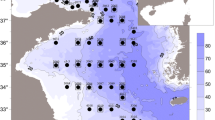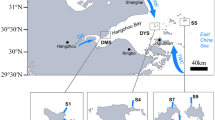Abstract
Most studies of spatial patterns of invertebrates in soft sediments have concentrated on populations of individual species. Those that examined patterns in communities have tended to employ categorical analytical techniques. Using macrofaunal abundance data from van Veen grab samples collected 20 to 100 m apart in known spatial arrangements from Scottish sea-lochs, the relationships between patterns in macrobenthic species composition and distances between samples were explored using matrix correlations in a non-parametric framework. Using a simple definition of spatial structure, i.e. that intersample distances are monotonically correlated with intersample species-similarity, spatial structure at each of seven stations was assessed using non-parametric Mantel tests based on rank-correlations. Changes in community structure were positively correlated with distance at all sites in Loch Etive, on both current-swept muddy sands and soft deep muds. Different components of the macrobenthos contributed to spatial pattern at each site. Simple spatial structure was also detectable at a muddy-sand site in Loch Creran, but neither on soft mud, nor at the soft mud site in the Firth of Lorne. The concept of rank-correlograms was introduced. These were used to examine the extent and form of spatial structure in different components of the macrobenthos at each site. Relationships between similarity and distance were neither simple nor consistent. Results were compared to previous studies which used the same data, and it was concluded that studies carried out at a particular scale, or on a particular component of the benthos, are unlikely to be successful in predicting spatial relationships at other scales or for other components of the benthos. Correlational rather than categorical analyses are recommended for exploratory studies of spatial relationships in the benthos. Analyses of the spatial structure at these seven sea-loch sites suggests that by ensuring that samples are at least 40 m apart an investigator is unlikely to underestimate variability or otherwise invalidate statistical analyses based on the use of the samples as replicates. Spacing samples up to 100 m apart may increase variability estimates, further reducing the chance of concluding that a difference exists when one does not.
Similar content being viewed by others
Author information
Authors and Affiliations
Additional information
Received: 4 May 1999 / Accepted: 8 March 2000
Rights and permissions
About this article
Cite this article
Somerfield, P., Gage, J. Community structure of the benthos in Scottish Sea-lochs. IV. Multivariate spatial pattern. Marine Biology 136, 1133–1145 (2000). https://doi.org/10.1007/s002270000311
Issue Date:
DOI: https://doi.org/10.1007/s002270000311




